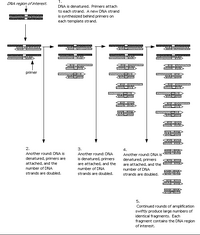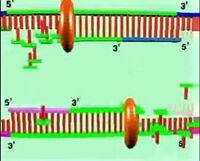BME100 f2014:Group21 L4
| Home People Lab Write-Up 1 | Lab Write-Up 2 | Lab Write-Up 3 Lab Write-Up 4 | Lab Write-Up 5 | Lab Write-Up 6 Course Logistics For Instructors Photos Wiki Editing Help | ||||||||||||||||||||||||||||||||||
|
OUR TEAM
LAB 4 WRITE-UPProtocolMaterials
Research and Development
The four main components of a PCR are Template DNA, Taq Polymerase, Primers, and Deoxyribonucleotides. Template DNA is the double stranded DNA that is to be amplified. It is a segment of someone or some organisms genome that wants be further studied, or it could be a strand of DNA that codes for a useful protein, like insulin. Taq Polymerase is a protein that is found in an organism, thermus aquaticus that lives in incredibly hot environments like hot springs. This enzyme is essential to PCR because of the high temperature that the reaction needs to occur at. The markers that show Taq Polymerase where to start and stop the DNA replication, and are what allow such specific strands to be targeted in PCR. Deoxyribonucleotides are Adenine, Thymine, Cytosine and Guanine. These are what make up the DNA and are what are paired together by Taq Polymerase. These are the parts of DNA that code for certain amino acids, which are the building blocks of proteins. The deoxyribonucleotides Adenine and Thymine pair together and Cytosine and Guanine pair together as well.
During PCR the four components listed above go through 6 different processes. The first step is to heat up the solution to 95°C for three minutes. This makes the solution hot to improve precision, because primers will not be able to bond to the template DNA in the wrong spots as it slowly heats up and splits in two. After the three minutes, the solution is kept at 95°C so the template DNA is denatured, and splits into two separate single strands of DNA. Once the DNA is denatured, it is cooled down to 57°C so that primers can bond/anneal to the two strands of DNA in the target region. This is the first time base-pairing occurs in the PCR. Primers have certain deoxyribonucleotides on them, so that they mirror the section of the DNA that is right before the strand that wished to be amplified starts and right after this region stops. These primers show the Taq Polymerase where to start and stop replication, and once they are bonded to the two strands of DNA the solution is heated backed up to 72°C. This is because Taq Polymerase works more efficiently at higher temperatures. During this phase, called “extension,” the Taq Polymerase quickly bonds the complementary base pairs (Adenine to Thymine and Cytosine to Guanine) to the strand of DNA. When this step is complete the replication of the original template DNA is complete, and there are two copies of it. This is the second time that base-pairing occurs during PCR. After this the solution is kept at 72°C for the final step to make sure that all of the targeted areas have been extended/replicated. After this the solution is kept at 4°C as a short term storage solution. The temperature is low so that there is little possibility of denaturation.
This picture was taken from http://bit.ly/1tJPyxx. This picture shows how and why primers are useful during a PCR.
This picture was taken from http://bit.ly/1nOY3FB. This picture shows how Taq Polymerase is used to combine free deoxyribonucleotides to their complementary base-pairs on single strands of DNA
| ||||||||||||||||||||||||||||||||||







